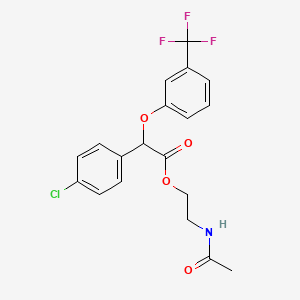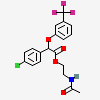Halofenate
PubChem CID
33584
Molecular Formula
Synonyms
- HALOFENATE
- 26718-25-2
- MK 185
- Halofenatum
- Halofenato
Molecular Weight
415.8 g/mol
Computed by PubChem 2.2 (PubChem release 2021.10.14)
Dates
- Create:2005-08-08
- Modify:2025-01-04
Description
Halofenate is a selective peroxisome proliferator-activated receptor gamma (PPAR-gamma) modulator with antilipidemic activity. Halofenate also decreases fasting plasma glucose in type 2 diabetic patients, but not normoglycemic subjects.
An antihyperlipoproteinemic agent and uricosuric agent.
Chemical Structure Depiction

2-acetamidoethyl 2-(4-chlorophenyl)-2-[3-(trifluoromethyl)phenoxy]acetate
Computed by Lexichem TK 2.7.0 (PubChem release 2021.10.14)
InChI=1S/C19H17ClF3NO4/c1-12(25)24-9-10-27-18(26)17(13-5-7-15(20)8-6-13)28-16-4-2-3-14(11-16)19(21,22)23/h2-8,11,17H,9-10H2,1H3,(H,24,25)
Computed by InChI 1.0.6 (PubChem release 2021.10.14)
BJBCSGQLZQGGIQ-UHFFFAOYSA-N
Computed by InChI 1.0.6 (PubChem release 2021.10.14)
CC(=O)NCCOC(=O)C(C1=CC=C(C=C1)Cl)OC2=CC=CC(=C2)C(F)(F)F
Computed by OEChem 2.3.0 (PubChem release 2024.12.12)
C19H17ClF3NO4
Computed by PubChem 2.2 (PubChem release 2021.10.14)
26718-25-2
- Halofenate
- MK 185
- MK-185
- MK185
- HALOFENATE
- 26718-25-2
- MK 185
- Halofenatum
- Halofenato
- MK-185
- Halofenatum [INN-Latin]
- Halofenato [INN-Spanish]
- K9TZK4MNO6
- Halofenate; Lipivas
- Halofenate [USAN:INN:BAN]
- HALOFENATE [INN]
- HALOFENATE [USAN]
- HALOFENATE [WHO-DD]
- 2-acetamidoethyl 2-(4-chlorophenyl)-2-[3-(trifluoromethyl)phenoxy]acetate
- Benzeneacetic acid, 4-chloro-alpha-(3-(trifluoromethyl)phenoxy)-, 2-(acetylamino)ethyl ester
- CHEMBL456071
- DTXSID9023120
- 2-Acetamidoethyl 2-(4-chlorphenyl)-2-(3-trifluormethylphenoxy)acetat
- (p-Chlorophenyl)((alpha,alpha,alpha-trifluoro-m-tolyl)oxy)acetic acid ester with N-(2-hydroxyethyl)acetamide
- Halofenatum (INN-Latin)
- Halofenato (INN-Spanish)
- (P-CHLOROPHENYL)((.ALPHA.,.ALPHA.,.ALPHA-TRIFLUORO-M-TOLYL)OXY)ACETIC ACID ESTER WITH N-(2-HYDROXYETHYL)ACETAMIDE
- ACETAMIDE, N-(2-HYDROXYETHYL)-, (P-CHLOROPHENYL)((.ALPHA.,.ALPHA.,.ALPHA.-TRIFLUORO-M-TOLYL)OXY)ACETATE (ESTER)
- ACETIC ACID, (P-CHLOROPHENYL)((.ALPHA.,.ALPHA.,.ALPHA.-TRIFLUORO-M-TOLYL)OXY)-, ESTER WITH N-(2-HYDROXYETHYL)ACETAMIDE
- BENZENEACETIC ACID, 4-CHLORO-.ALPHA.-(3-(TRIFLUOROMETHYL)PHENOXY)-, 2-(ACETYLAMINO)ETHYL ESTER
- UNII-K9TZK4MNO6
- MBX 102;JNJ 39659100
- Halofenate (USAN/INN)
- SCHEMBL635325
- DTXCID103120
- BDBM50266371
- SB16866
- HY-14998
- CS-0003688
- D04411
- Q27282141
- 2-acetamidoethyl (3-trifluoromethylphenoxy)(4-chlorophenyl)acetate
- 2-(acetylamino)ethyl (4-chlorophenyl)[3-(trifluoromethyl)phenoxy]acetate
- racemic 2-Acetamidoethyl 4-Chlorophenyl-(3-trifluoro methylphenoxy)-acetate
- (-)-(4-Chloro-phenyl)-(3-trifluoromethyl-phenoxy)-acetic acid 2-acetylamino-ethyl ester
- (P-CHLOROPHENYL)((ALPHA,ALPHA,.ALPHA-TRIFLUORO-M-TOLYL)OXY)ACETIC ACID ESTER WITH N-(2-HYDROXYETHYL)ACETAMIDE
- 24136-24-1
- ACETAMIDE, N-(2-HYDROXYETHYL)-, (P-CHLOROPHENYL)((ALPHA,ALPHA,ALPHA-TRIFLUORO-M-TOLYL)OXY)ACETATE (ESTER)
- ACETIC ACID, (P-CHLOROPHENYL)((ALPHA,ALPHA,ALPHA-TRIFLUORO-M-TOLYL)OXY)-, ESTER WITH N-(2-HYDROXYETHYL)ACETAMIDE
Property Name
Property Value
Reference
Property Name
Molecular Weight
Property Value
415.8 g/mol
Reference
Computed by PubChem 2.2 (PubChem release 2021.10.14)
Property Name
XLogP3-AA
Property Value
4.3
Reference
Computed by XLogP3 3.0 (PubChem release 2021.10.14)
Property Name
Hydrogen Bond Donor Count
Property Value
1
Reference
Computed by Cactvs 3.4.8.18 (PubChem release 2021.10.14)
Property Name
Hydrogen Bond Acceptor Count
Property Value
7
Reference
Computed by Cactvs 3.4.8.18 (PubChem release 2021.10.14)
Property Name
Rotatable Bond Count
Property Value
8
Reference
Computed by Cactvs 3.4.8.18 (PubChem release 2021.10.14)
Property Name
Exact Mass
Property Value
415.0798202 Da
Reference
Computed by PubChem 2.2 (PubChem release 2021.10.14)
Property Name
Monoisotopic Mass
Property Value
415.0798202 Da
Reference
Computed by PubChem 2.2 (PubChem release 2021.10.14)
Property Name
Topological Polar Surface Area
Property Value
64.6 Ų
Reference
Computed by Cactvs 3.4.8.18 (PubChem release 2021.10.14)
Property Name
Heavy Atom Count
Property Value
28
Reference
Computed by PubChem
Property Name
Formal Charge
Property Value
0
Reference
Computed by PubChem
Property Name
Complexity
Property Value
524
Reference
Computed by Cactvs 3.4.8.18 (PubChem release 2021.10.14)
Property Name
Isotope Atom Count
Property Value
0
Reference
Computed by PubChem
Property Name
Defined Atom Stereocenter Count
Property Value
0
Reference
Computed by PubChem
Property Name
Undefined Atom Stereocenter Count
Property Value
1
Reference
Computed by PubChem
Property Name
Defined Bond Stereocenter Count
Property Value
0
Reference
Computed by PubChem
Property Name
Undefined Bond Stereocenter Count
Property Value
0
Reference
Computed by PubChem
Property Name
Covalently-Bonded Unit Count
Property Value
1
Reference
Computed by PubChem
Property Name
Compound Is Canonicalized
Property Value
Yes
Reference
Computed by PubChem (release 2021.10.14)
Follow these links to do a live 2D search or do a live 3D search for this compound, sorted by annotation score. This section is deprecated (see here for details), but these live search links provide equivalent functionality to the table that was previously shown here.
Same Connectivity Count
Same Parent, Connectivity Count
Mixtures, Components, and Neutralized Forms Count
Similar Compounds (2D)
Similar Conformers (3D)
Uricosuric Agents
Gout suppressants that act directly on the renal tubule to increase the excretion of uric acid, thus reducing its concentrations in plasma. (See all compounds classified as Uricosuric Agents.)
Hypolipidemic Agents
Substances that lower the levels of certain LIPIDS in the BLOOD. They are used to treat HYPERLIPIDEMIAS. (See all compounds classified as Hypolipidemic Agents.)
Patents are available for this chemical structure:
https://patentscope.wipo.int/search/en/result.jsf?inchikey=BJBCSGQLZQGGIQ-UHFFFAOYSA-N
- CAS Common ChemistryLICENSEThe data from CAS Common Chemistry is provided under a CC-BY-NC 4.0 license, unless otherwise stated.https://creativecommons.org/licenses/by-nc/4.0/Benzeneacetic acid, 4-chloro-α-[3-(trifluoromethyl)phenoxy]-, 2-(acetylamino)ethyl ester, (+)-https://commonchemistry.cas.org/detail?cas_rn=24136-24-1
- ChemIDplusHalofenate [USAN:INN:BAN]https://pubchem.ncbi.nlm.nih.gov/substance/?source=chemidplus&sourceid=0026718252ChemIDplus Chemical Information Classificationhttps://pubchem.ncbi.nlm.nih.gov/source/ChemIDplus
- EPA DSSToxCompTox Chemicals Dashboard Chemical Listshttps://comptox.epa.gov/dashboard/chemical-lists/
- FDA Global Substance Registration System (GSRS)LICENSEUnless otherwise noted, the contents of the FDA website (www.fda.gov), both text and graphics, are not copyrighted. They are in the public domain and may be republished, reprinted and otherwise used freely by anyone without the need to obtain permission from FDA. Credit to the U.S. Food and Drug Administration as the source is appreciated but not required.https://www.fda.gov/about-fda/about-website/website-policies#linking
- ChEMBLLICENSEAccess to the web interface of ChEMBL is made under the EBI's Terms of Use (http://www.ebi.ac.uk/Information/termsofuse.html). The ChEMBL data is made available on a Creative Commons Attribution-Share Alike 3.0 Unported License (http://creativecommons.org/licenses/by-sa/3.0/).http://www.ebi.ac.uk/Information/termsofuse.htmlChEMBL Protein Target Treehttps://www.ebi.ac.uk/chembl/g/#browse/targets
- Comparative Toxicogenomics Database (CTD)LICENSEIt is to be used only for research and educational purposes. Any reproduction or use for commercial purpose is prohibited without the prior express written permission of NC State University.http://ctdbase.org/about/legal.jsp
- Human Metabolome Database (HMDB)LICENSEHMDB is offered to the public as a freely available resource. Use and re-distribution of the data, in whole or in part, for commercial purposes requires explicit permission of the authors and explicit acknowledgment of the source material (HMDB) and the original publication (see the HMDB citing page). We ask that users who download significant portions of the database cite the HMDB paper in any resulting publications.http://www.hmdb.ca/citingArhalofenatehttp://www.hmdb.ca/metabolites/HMDB0248593
- Japan Chemical Substance Dictionary (Nikkaji)
- KEGGLICENSEAcademic users may freely use the KEGG website. Non-academic use of KEGG generally requires a commercial licensehttps://www.kegg.jp/kegg/legal.htmlTarget-based classification of drugshttp://www.genome.jp/kegg-bin/get_htext?br08310.keg
- NCI Thesaurus (NCIt)LICENSEUnless otherwise indicated, all text within NCI products is free of copyright and may be reused without our permission. Credit the National Cancer Institute as the source.https://www.cancer.gov/policies/copyright-reuseNCI Thesaurushttps://ncit.nci.nih.gov
- Springer Nature
- Wikidatahalofenatehttps://www.wikidata.org/wiki/Q27282141
- Medical Subject Headings (MeSH)LICENSEWorks produced by the U.S. government are not subject to copyright protection in the United States. Any such works found on National Library of Medicine (NLM) Web sites may be freely used or reproduced without permission in the U.S.https://www.nlm.nih.gov/copyright.htmlUricosuric Agentshttps://www.ncbi.nlm.nih.gov/mesh/68014528Hypolipidemic Agentshttps://www.ncbi.nlm.nih.gov/mesh/68000960
- PubChemPFAS and Fluorinated Compounds in PubChemhttps://gitlab.com/uniluxembourg/lcsb/eci/pubchem-docs/-/raw/main/pfas-tree/PFAS_Tree.pdf?inline=false
- MolGenieMolGenie Organic Chemistry Ontologyhttps://github.com/MolGenie/ontology/
- PATENTSCOPE (WIPO)SID 403435078https://pubchem.ncbi.nlm.nih.gov/substance/403435078
- NCBI
CONTENTS

